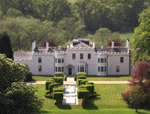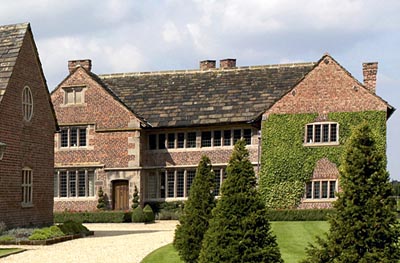Country houses for sale in Cheshire
Cheshire is a county filled with immaculate, well-preserved country houses for sale


Affluent east Cheshire villages in and around the Golden Triangle south of Manchester bounded by Alderley Edge, Prestbury and Wilmslow are among the most expensive and sought-after places to live in the UK outside central London. Historically overseen by a handful of powerful landowners, such as the Stanleys and the De Traffords, the area became a Mecca for Manchester industrialists with the expansion of the railways in the 1840s, when the Manchester and Birmingham Railway Company offered free season tickets for 20 years to Manchester businessmen who built houses with a rateable value of more than £50 within a mile of the station at Alderley Edge.
Many of those smart Victorian villas were built on land provided by those same influential landowners, some of whom later took advantage of the area's burgeoning popularity to sell their historic family houses to successful local entrepreneurs when the tide (and taxation) turned against the landed classes.
Grade II*-listed Lower Manor at Mottram St Andrew, two miles north of Prestbury, owes its reincarnation as a classic small country estate to an epic six-year restoration programme masterminded and managed every step of the way by its owner, a well-known Cheshire businessman who bought the property 10 years ago. Launched on the market in last week's Country Life, the manor, set in just under 90 acres of beautifully manicured gardens, grounds and parkland, is for sale through the Wilmslow office of Jackson-Stops & Staff (01625 540340), at a guide price of £12 million.
Lower Manor (or Lower House Farm, in its English Heritage listing) is one of several ancient manor houses in Mottram St Andrew owned from the 12th century by the Norman Motterum family, who held high office in the area in recognition of their service to the Crown. In medieval times, a junior branch of the family inherited the Mottershead estate, of which Lower House Farm was a part, and which remained a working farmstead until 2002.
Wilmslow-based architect James Wareham, who has been involved with the entire restoration project from its inception, looks back in wonder at the ‘fanatical' attention to detail shown by the owner in his determination to re-create the farmstead's original concept and layout. ‘Amazingly, given the building's Grade II* listing and the many different periods involved in its development, the original planning process was virtually trouble-free, largely thanks to the support of Cheshire East planning officer Michael Scammell and historic-buildings expert Peter de Figueiredo of English Heritage. For example, we were allowed to reproduce the original oak-timbered house as a new black-and-white extension to the main brick building.
‘It was only when we started to remove the various layers of materials overlaid over the centuries that we realised the full significance of the building, which is also basically timber-framed, with a 13th-century core that includes the impressive inglenook fireplace in the sitting room. Another exciting find was the series of medieval friezes uncovered in what is now the drawing room.'
The aim of the project was not only to enhance and preserve the manor's historic fabric, but also to create a spacious family home with modern amenities such as underfloor heating, a large country kitchen and stylish bathrooms. Authentic materials were sourced wherever they could be found, including seasoned oak-mostly imported from Austria-which is a striking element both of the main house and the spacious entertaining barn, one of the farmstead's impressive secondary buildings, which include a splendid stable yard. Accommodation in the main house flows off the entrance hall and includes four reception rooms, a grand master suite, four further bedrooms and four bathrooms. There is also planning consent for an indoor swimming pool and the creation of a sizeable lake to the east of the property.
Sign up for the Country Life Newsletter
Exquisite houses, the beauty of Nature, and how to get the most from your life, straight to your inbox.

The history of Grade II*-listed Whirley Hall at Henbury, near Alderley Edge, is just as rich. For sale through Andrew J. Nowell (01625 585905) and Strutt & Parker (01244 354880) at a guide price of £2.75m for the whole, the charming, late-17th-century house-originally part of a moated, timber-framed hall, now demolished-stands in some 100 acres of gardens, grounds and farmland, and is for sale as a whole or in up to six lots.
The 7,339sq ft house was in a state of disrepair when, in 1952, it was bought and restored by the eminent Manchester industrialist the late Sir William Mather and his wife, Eleanor. Now for sale following her death last year at the age of 94, and in need of a gentle ‘50-year makeover', Whirley Hall has accommodation on three floors, including eight bedrooms, five bathrooms and an artist's studio.
Chester-based Charlie Kann-reuther of Savills has happy cricketing memories of the Cherry Hill estate at Malpas, south Cheshire, which boasted its own cricket ground and club when in the hands of its previous owners, Miles and Sally Clarke, whose family home it was for 30 years. The present owner, who bought Cherry Hill in 2004, has renovated the handsome country house, which was built in the late 1700s, extended and remodelled in the late 1800s, and again in the 1920s, and has four fine reception rooms, seven bedrooms and five bathrooms. A three-bedroom lodge provides additional staff or family accommodation.
Cherry Hill House stands in a wonderfully private position in the middle of its 44 acres of grassland, with magnificent views across the rolling Cheshire countryside. Outbuildings include a two-storey, L-shaped range adjoining a cobbled yard and incorporating a coach house, stores, stabling, a loft, garages and party rooms. Other amenities include beautiful gardens, a pool, a tennis court, a lake and parkland. Mr Kannreuther, who is also handling the sale of Cherry Hill this time round, quotes a guide price of £3.5m.
* Subcribe to Country Life magazine and get our new Ipad version at no extra cost
Country Life is unlike any other magazine: the only glossy weekly on the newsstand and the only magazine that has been guest-edited by HRH The King not once, but twice. It is a celebration of modern rural life and all its diverse joys and pleasures — that was first published in Queen Victoria's Diamond Jubilee year. Our eclectic mixture of witty and informative content — from the most up-to-date property news and commentary and a coveted glimpse inside some of the UK's best houses and gardens, to gardening, the arts and interior design, written by experts in their field — still cannot be found in print or online, anywhere else.
-
 Designer's Room: A solid oak French kitchen that's been cleverly engineered to last
Designer's Room: A solid oak French kitchen that's been cleverly engineered to lastKitchen and joinery specialist Artichoke had several clever tricks to deal with the fact that natural wood expands and contracts.
By Amelia Thorpe Published
-
 Chocolate eggs, bunnies and the Resurrection: Country Life Quiz of the Day, April 18, 2025
Chocolate eggs, bunnies and the Resurrection: Country Life Quiz of the Day, April 18, 2025Friday's quiz is an Easter special.
By James Fisher Published
